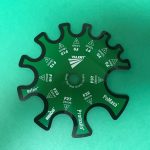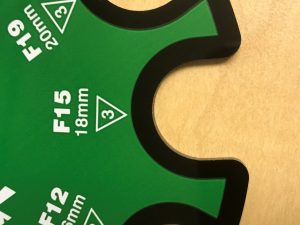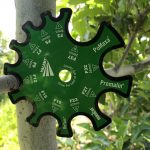Written by Karen Lewis, WSU Extension. May 21, 2018
Green fruit thinning is the final opportunity to adjust and set your final fruit number per leader and the placement of fruit down the limb. If your pruning was based on bud counts and if your blossom or chemical thinning job was near perfect then green fruit thinning merely becomes a cleanup job for spacing out fruit, removal of damaged fruit, small fruit and clustered fruit.
If on the other hand you did not hit the bullseye and need to adjust crop load, then you might want to take the time now to get the results you need. The equilifruit disc is a tool to improve the consistency of fruit number adjustment across a block (photo # 1).

The disc was developed by the National Institute for Agricultural Research (INRA) in France. The disc is used for both artificial spur extinction and green fruit thinning operations. It can be used to inform and set a thinning strategy, calibrate and recalibrate employees, and evaluate employees and/or the operation.
Scientist have shown that the diameter of the trunk is a good indication of how many fruit the tree can carry for a given size / weight. In cylindrical, spindle type trees you can use limb diameter instead of trunk diameter to determine number of fruit per limb. The trunk gauge (photo #2) measures trunk cross sectional area (TCSA), while the equilifruit disc measures the limb cross sectional area of individual limbs (LCSA). The disc is used to adjust the

number of fruit to a target number of fruit per limb cross-sectional area (cm², LCSA).
The round disc has 11 semi-circular notches of varying diameters from 8mm to 28mm. Each notch has 3 corresponding numbers: (photo #3)
- the diameter in millimeters to measure limb diameter;
- the F value indicating the number of fruit you should leave

Photo #3 Three numbers on Equilifruit Disc. on the limb
(F value = Fruit value); - the delta number (in the triangle) indicating the plus / minus range from the F-value.
How to use:
- Place the disc approximately 1” from trunk to avoid the collar. Find the correct notch for the limb. You want a snug fit, not a loose fit. (Photo #4)
- Count number of fruit on the limb.
- If the number of fruit is greater than the recommended F value for that notch then reduce number of fruit.
Example: If the limb is 18mm, you should leave 15 fruit +/- 3 fruit (photo #3) on the limb.
Penn State Trials | Kon and Schupp
Kon and Schupp conducted trials in Golden Delicious, Gala and Honeycrisp trees trained to spindle type architecture. They had three thinning treatments.
1. Thin to F value on equilifruit disc that corresponds to limb diameter;
2. Thin fruit using a spacing rule of 7-8 inches apart, and;
3. Control – no green fruit thinning.

Golden Delicious trees thinned with the disc had a 24% increase in fruit weight with yields comparable to control trees. Hand thinning with the thinning rule of 7-8” spacing increased fruit size by 34 percent, but total yield was reduced by 30%.
Both the equilifruit disc and the spacing rule treatments reduced the crop load of Gala by roughly 50%. Yields were not reduced by either hand thinning treatment. On trees thinned to an F value, 15 percent of the fruit were larger than 3 inches, compared with 12 percent in the spacing treatment and 5 percent for the control. Gala trees had a high crop load before hand thinning.
Hand thinning treatments did not affect Honeycrisp yields. However, 44 percent of the fruit from trees thinned using the spacing rule were greater than 3.5 inches in diameter. Only 12 percent of fruit from trees treated with the F value treatment were larger than 3.5 inches in diameter. The F value treatment had 73 percent of its fruit in the size range of 3.0 to 3.5 inches, compared with 61 percent of the control and 55 percent of those thinned using the spacing rule. These trees also had a higher than desired crop load at the time of thinning.
In this trial, thinning to the F value did not reduce yield when compared to the control. The use of this tool resulted in either larger fruit or a higher proportion of fruit in desirable size categories.
Additional comments
Limb diameter estimates bearing surface so caution needs to be followed when you use this in redirected limbs like what you can get with bench cuts. Practitioners and scientists say that this tool is most accurate in spindle type trees with renewal style pruning – that is, trees with small diameter limbs.
What about fruit grown on the leader itself? Use the equilifruit disc directly on the leader and thin accordingly… with a dose of good judgement.
Some suggest that on mature trees you should stick to the F value and that on young trees you should use reduce the F value by the delta number. Seems straight forward, but I think there might be opportunity to tweak these numbers based on several conditions including cultivar, fruit size target and tree vigor. You can always mark up your disc with numbers that better represent your block and the crop load you want. Or, make your own discs with numbers that get you the numbers you want across the entire block. Note that Cornell trunk Gauge does have different numbers for biennial bearing varieties and annual bearing varieties (photo #2).
Why the limb instead of the trunk? It’s easier to measure (no bending – which can lead to inaccurate readings). It’s easier to calibrate the human eye to a limb than a trunk. It’s easier to be correct and consistent across a limb than it is for a whole tree.
Over thinning and under thinning are not in your playbook. I am not sure where your line is but being off by 10% either way can potentially impact packouts. Using a tool to calibrate and recalibrate your employees is a real opportunity to get consistent “just right” green fruit thinning across your apple blocks. The disc is also a strong evaluation tool for supervisors.
I think in general we underestimate the value of recalibration for crews who are doing tasks like thinning green fruit. I am confident that you will not have enough discs for all employees to wear around their necks all day, so first things first. In the morning demonstrate the use and show them what the different diameters look like and the difference in the corresponding numbers. Explain how the limb diameter and number of fruit correspond. Tell them why getting the right number is important to you and them. Do this again after breaks if reasonable and after lunch for sure. Make sure every supervisor and or crew boss has a disc and are empowered to make recalibration / training checks throughout the day.
Thanks to Byron Phillips at Valent for giving me a limited supply of equilifruit discs and trunk gauges. Contact me via email if you want to put them to use this season.
References
Tom Kon, Jim Schupp, Edwin Winzeler and Melanie Schupp, Department of Horticulture, Penn State Fruit Research and Extension Center Apple Crop Load Management – A Hand-thinning Gauge
Thomas M. Kon and James R. Schupp. 2013. Thinning tall spindle apple based on estimations made with a hand-thinning gauge. HortTechnology vol.23 no.6 830-835
Contact
WSU Extension Specialist
509-760-2263
Fruit Matters articles may only be republished with prior author permission © Washington State University. Republished articles with permission must include: “Originally published by Washington State Tree Fruit Extension Fruit Matters at treefruit.wsu.edu” along with author(s) name, and a link to the original article.

